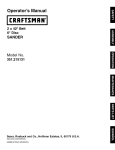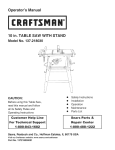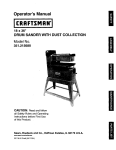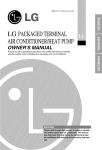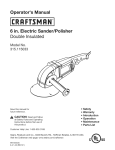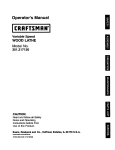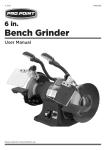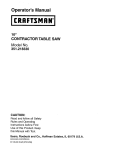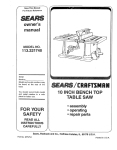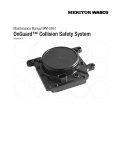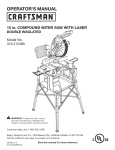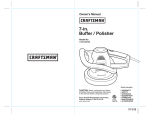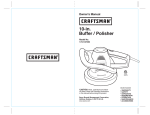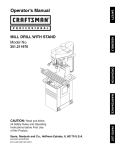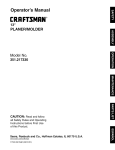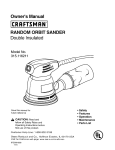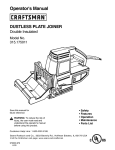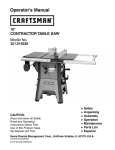Download Craftsman 351.217030 Operator`s manual
Transcript
Operator's Manual 8"JOINTER AND JOINTER STAND Model No. 351.21 7030 CAUTION: Read and follow all Safety Rules and Operating Instructions before First Use of this Product. Sears, Roebuck and Co., Hoffman www.sears.com/craftsman 23056.00 Draft (01/21/05) Estates, IL 60179 U.S.A. PREPARE Warranty .................................... SafetyRules............................... Unpacking.................................. Assembly................................. Installation ................................. KnowYourJointer............................ Operation................................ Maintenance ................................ Troubleshooting ............................. PartsIllustration andList ................... 2 2-3 3 3-5 5-6 7 7-11 11 12 14-19 Keep work area clean. Cluttered work areas invite accidents. • Do not use power tools in dangerous environments. • Do not use power tools in damp or wet locations. Do not expose power tools to rain. • Work area should be properly lighted. • Proper electrical receptacle should be available for tool. Three prong plug should be plugged directly into properly grounded, three-prong receptacle. • Extension cords should have a grounding prong and the three wires of the extension cord should be of the correct gauge. • Keep visitors at a safe distance from work area. • Keep children out of workplace. Make workshop childproof. Use padlocks, master switches or remove switch keys to prevent any unintentional use of power tools. TOOL SHOULD If this product is used for commercial or rental purposes, this warranty will apply for 90 days from the date of purchase. This warranty applies only while this product is used in the United States. Always unplug tool prior to inspection. • Consult manual for specific maintaining and adjusting procedures. • Keep tool lubricated and clean for safest operation. • Remove adjusting tools. Form habit of checking to see that adjusting tools are removed before switching machine on. • Keep all parts in working order. Check to determine that the guard or other parts will operate properly and perform their intended function. • Check for damaged parts. Check for alignment of moving parts, binding, breakage, mounting and any other condition that may affect a tool's operation. • A guard or other part that is damaged should be properly repaired or replaced. Do not perform makeshift repairs. (Use parts list provided to order replacement parts.) WARNING: For your own safety, read all of the rules and precautions before operating tool. KNOW HOW TO USE TOOL CAUTION: Always follow proper operating procedures as defined in this manual even if you are familiar with use of this or similar tools. Remember that being careless for even a fraction of a second can result in severe personal injury. BE PREPARED BE MAINTAINED • This warranty gives you specific legal rights, and you may also have other rights which vary from state to state. Sears, Roebuck and Co., Dept. 817WA, Hoffman Estates, IL 60179 AREA FOR JOB • FULL ONE YEAR WARRANTY If this product fails due to a defect in material or workmanship within one year from the date of purchase, Sears will at its option repair or replace it free of charge. Contact your nearest Sears Service Center (1-800-4-MY-HOME) to arrange for product repair, or return this product to place of purchase for replacement. WORK • Use right tool for job. Do not force tool or attachment to do a job for which it was not designed. • Disconnect tool when changing blades. • Avoid accidental start-up. Make sure that the switch is in the OFF position before plugging in. • Do not force tool. It will work most efficiently at the rate for which it was designed. • Keep hands away from moving parts and cutting surfaces. FOR JOB • Wear proper apparel. Do not wear loose clothing, gloves, neckties, rings, bracelets or other jewelry which may get caught in moving parts of machine. • Wear protective hair covering to contain long hair. • Wear safety shoes with non-slip soles. • • Wear safety glasses complying with United States ANSI Z87.1. Everyday glasses have only impact resistant lenses. They are NOT safety glasses. Never leave tool running unattended. Turn the power off and do not leave tool until it comes to a complete stop. • Do not overreach. Keep proper footing and balance. • Wear face mask or dust mask if operation is dusty. • • Be alert and think clearly. Never operate power tools when tired, intoxicated or when taking medications that cause drowsiness. Never stand on tool. Serious injury could occur if tool is tipped or if blade is unintentionally contacted. • Know your tool. Learn the tool's operation, application and specific limitations. © Sears, Roebuck and Co. 2 • Userecommended accessories (referto page19). Useofimproperaccessories maycauseriskof injuryto persons. • Handleworkpiececorrectly. Protecthandsfrompossibleinjury. • Turnmachineoff if itjams.Bladejamswhenit digs toodeeplyintoworkpiece. (Motorforcekeepsit stuckinthe work.) CAUTION:Thinksafety!Safetyis a combination of operatorcommonsenseandalertnessatalltimes whentoolis beingused. G [ Referto Figure1. Checkforshippingdamage.If damagehasoccurred,a claimmustbefiledwithcarrier.Checkforcompleteness.Immediately reportmissingpartsto dealer. Thejointeris shippedcompletein onecratealongwith a cartonforthestand.Additionalpartswhichneedto befastenedtojointerandjointerstandshouldbelocatedandaccounted forbeforeassembling. A. Jointer B. Stand C. Fence D. FenceBracketAssembly E. FenceLockingHandle E PushBlock(2) G. PushBlockHolder H. BladeGauge I. BladeGuardAssembly J. BeltGuard K. LockingStuds(3) L. Handwheel Assembly (2) M.DustPort N. V-Belt(2) AngleGauge(NotShown) Hardware Bag(PartNo.23200.00) includesFenceGrip Handle,M10FlatWasher(3),M10LockWasher(3), M5x 10SocketHeadBolt(4),M5FlatWasher(4),5 x 5 x 25mmKey(2),3,4 and5mmhexwrenches, 8/10mm,12/14mm and17/19mm openendwrenches. IMPORTANT: Tableis coatedwitha protectant. To ensureproperfit andoperation,removecoating. Coatingis easilyremovedwithmildsolvents,suchas mineralspirits,anda softcloth.Avoidgettingsolution onpaintor anyofthe rubberor plasticparts.Solvents maydeteriorate thesefinishes.Usesoapandwateron paint,plasticor rubbercomponents. Aftercleaning, coverallexposedsurfaceswitha lightcoatingof oil. Pastewaxis recommended fortabletops. WARNING:Neverusehighlyvolatilesolvents.Nonflammable solventsarerecommended toavoidpossible firehazard. E / M [ :igure 1 - Unpacking CAUTION: Do not attempt assembly if parts are missing. Use this manual to order replacement parts. JOINTER INSTALLATION Refer to Figure 2. Before jointer or stand are assembled, a suitable location should be chosen. The jointer and jointer stand weigh approximately 400 Ibs when completely assembled. They should be assembled on location. • Jointer needs to be set on a flat, level surface. • Make sure there is ample room on either side of jointer to accommodate desired workpiece size. • Good lighting and correct power supply are also required for a proper work area. • Place stand in its designated spot. Door panel for access to motor is on back side. .._e_Blade Guard Assembly T-Handle Bolt \ Key Handwheel Screw Flat Washer Lock Washer Locking Stud =igure 2 - Jointer Assembly MOUNT JOINTER MOUNT BLADE GUARD Refer to Figure 2, page 3. Refer to Figures 2 and 3, pages 3 and 4. • • Jointer is held to stand by three locking studs, three lock washers and flat washers. The blade guard assembly employs a spring loaded return located between the blade guard and guard shaft. Blade guard assembly can be attached or removed without altering spring action. • Threaded mounting holes in base of jointer must be lined up with holes in top of stand. Using a flashlight will assist in quickly locating the holes. The infeed table includes a mounting block which is part of the casting. Insert guard shaft into the mounting block. • One location for a stud which fastens the jointer to stand is reached through the chip chute. Position blade guard assembly with spring pin facing toward front of infeed table (see Figure 3). • Secure in position with T-handle bolt. • Tension will be applied to guard when fence is installed. Place jointer on stand and attach it. NOTE: At least two people are required to lift the 300 lb. jointer. • • • • Location for other two locking studs are reached through the doorway of the stand. INSTALL V-BELTS Refer to Figure 12. Jointer uses a two-belt system for more efficient power transfer. Motor mounting plate pivots at one side to provide for easy mounting and easy belt tensioning. • Loosen front bolts (Key No. 11) so that motor mounting plate (Key No. 9) is loose. NOTE: The front bolts are located in the slotted end of the plate. • Pull up on motor mounting plate and install V-Belts onto driven pulley and motor pulley. • Apply tension to the belts by pushing down on plate and tightening bolts. • Make sure belts are tensioned properly. Belt is properly tensioned when moderate pressure applied to the belts (between the pulleys) will deflect the belts about '/2". • Figure 3 - Install Blade Guard MOUNT • Loosen the two socket head bolts (Key No. 41) of the outfeed table. Do not remove bolts. Loosen just enough to fit bracket over bolts. • Place the fence bracket assembly over the bolts. Carefully tighten bolts, making sure to keep the top surfaces of the fence bracket assembly and outfeed table flush to each other. HANDWHEELS Handwheels attach to the leadscrews for table height adjustment. The leadscrew is coupled to the handwheel with a key. Loosen and remove screw and flat washer from leadscrew. • • Place key into keyway on the leadscrew. Slide handwheel onto leadscrew. • Fasten handwheel to leadscrew with screw and flat washer. MOUNT MOUNT • Swing blade guard forward, over and past cutterhead. Secure in position. • Loosen hex nuts (Key No. 6) several turns. • Position fence in front of the link (Key No. 10). Make sure blade relief in fence is against the table, over the cutterhead. • Turn the cone point set screws (Key No. 7) equally until they seat firmly in the pivot connectors (Key No. 5). • Check that fence is parallel to both jointer tables. If not parallel, loosen set screws, turn pivot connector as needed, and then tighten set screws into pivot connectors. Refer to Figure 13. Loosen and remove two bolts and washers (Key Nos. 8 and 44) on the back of the jointer base. • Position belt guard (Key No. 15) on back of jointer and secure in position with bolts and washers. FENCE TO BRACKET Refer to Figures 4 and 14, pages 5 and 19. BELT GUARD • ASSEMBLY • Refer to Figure 2, page 3. • BRACKET Refer to Figure 13. If belts do not have the proper tension, the motor mounting plate can be adjusted by loosening front bolts. Move plate, tighten bolts and recheck belt tension. MOUNT FENCE 4 • Secure set screws by tightening hex nuts. • Remove hex head packing bolt from top of fence bracket assembly and discard. Insert fence angle lock handle and thread into nut. Make sure nut is aligned in bracket slot. • Remove socket head bolt from fence block (Key No. 16). Insert bolt through fence and thread bolt securely into block. • Attach fence grip (Key No. 3) to fence. • Release blade guard. Blade guard should swing against fence and completely cover cutterhead. burnout. Heavy loads require that voltage at motor terminals be no less than the voltage specified on nameplate. GROUNDING INSTRUCTIONS WARNING: Improper connection of equipment grounding conductor can result in the risk of electrical shock. Equipment should be grounded while in use to protect operator from electrical shock. Check with a qualified electrician if grounding instructions are not understood or if in doubt as to whether the tool is properly grounded. This tool is equipped with an approved 3-conductor cord rated up to 250V and a 3-prong grounding type plug rated at 250V (See Figure 5) for your protection against shock hazards. Do not remove or alter grounding prong in any manner. In the event of a malfunction or breakdown, grounding provides a path of least resistance for electrical shock. WARNING: Do not permit fingers to touch the terminals of plug when installing or removing from outlet. Figure 4 - Mounting MOUNT gle Lock Handle (Packing Bolt Removed) Fence to Bracket DUST COLLECTION Grounding Pin PORT Refer to Figure 2. :igure 5 - Grounding • Jointer stand has a built-in chip chute. The dust collection port covers the end of the chip chute. • Attach port with pan head screws and flat washers. • Port has a 4" diameter opening to attach to a standard hose. Plug must be plugged into a 230V matching outlet (See Figure 5) that is properly installed and grounded in accordance with all local codes and ordinances. Do not modify plug provided. If it will not fit in outlet, have proper outlet installed by a qualified electrician. • Port will not inhibit the chip flow. A dust collector must be used. Inspect tool cords periodically, and if damaged, have repaired by an authorized service facility. ATTACH PUSH BLOCK SHELF Refer to Figure 12. • • Place shelf (Key No. 29) over bolt and washer (Key Nos. 17 and 27) located on stand beneath infeed table. Tighten bolt to secure shelf in position. Methods Green (or green and yellow) conductor in cord is the grounding wire. If repair or replacement of the electric cord or plug is necessary, do not connect the green (or green and yellow) wire to a live terminal. Where a 2-prong wall must be replaced with receptacle installed in Code and local codes receptacle is encountered, it a properly grounded 3-prong accordance with National Electric and ordinances. WARNING: This work should be performed by a qualified electrician. POWER SOURCE Refer to Figure 5. WARNING: Do not connect jointer to the power source until all assembly steps have been completed. The motor is designed for operation on the voltage and frequency specified. Normal loads will be handled safely on voltages not more than 10% above or below specified voltage. Running the unit on voltages which are not within range may cause overheating and motor EXTENSION • • • CORDS The use of any extension cord will cause some drop in voltage and loss of power. Wires of the extension cord must be of sufficient size to carry the current and maintain adequate voltage. Use the table to determine the minimum wire size (A.W.G.) extension cord. • • Use only 3-wire extension cords having 3-prong grounding type plugs and 3-pole receptacles which accept the tool plug. -q If the extension cord is worn, cut, or damaged in any way, replace it immediately. EXTENSION CORD LENGTH Wire Size A.W.G. Up to 50 ft .................................. 12 White NOTE: Using extension cords over 50 ft. long is not recommended. _ White MOTOR The stand is assembled with motor and wiring installed. The 230 Volt AC capacitor start motor has the following specifications: Horsepower ................................. Voltage ................................... Amperes .................................. Hertz ..................................... Phase .................................. RPM .................................... ELECTRICAL 2 230 8.6 60 Black Single 3450 Figure 6 - Wiring Schematic CONNECTIONS OVERLOAD Refer to Figure 6. PROTECTION The magnetic contactor has overload protection that helps to prevent damage to the motor. The overload protection will automatically turn off the magnetic contactor when an overload occurs. Be sure to disconnect jointer from power source when resetting overload protector. The protection is reset by opening the contactor box and pressing the reset button. WARNING: All electrical connections must be performed by a qualified electrician. Make sure unit is off and disconnected from power source while motor is mounted, connected, reconnected or anytime wiring is inspected. Jointer has an approved 230 volt three-conductor line cord with a three-prong grounding type plug, and a 230 volt magnetic contactor that is prewired in the factory (See Figure 6). • Black CHECK Connect jointer to a supply circuit protected by a 20 AMP circuit breaker or time delay fuse. 6 CONNECTIONS • Plug in the line cord to a 230 volt power source. • Turn and release the emergency stop button. • Depress the start button. The motor must rotate counterclockwise facing shaft end. • Depress the stop button. The motor must stop. • Depressing the start button with the emergency stop button pressed down must not start the motor. • If any of the above steps do not work properly, disconnect jointer from power source and recheck the connections. lO \ 11 \ 12 1 Stand 8 Fence 2 Push Blocks 9 Fence Grip 3 4 5 6 Start/Stop Switch Emergency Stop Switch Depth Scale and Limit Stop Infeed Table Hand Wheel 7 Infeed Table 10 Fence Angle Lock Handle 11 Outfeed Table 12 Outfeed Table Hand Wheel 13 Dust Collection Port SPECIFICATIONS Table size ............................ Refer to Figures 7-14, pages 8-10 and 19. Craftsman 8" Jointer is used to surface the faces and edges of boards, produce a flat surface on warped boards and shape rabbets, bevels, chamfers and tapers. The jointer features heavy cast iron infeed and outfeed tables with precision ground work surfaces and leadscrews for precise table height adjustments. Rigid, center mount guide fence is fully adjustable and is provided with positive stops at 45, 90, and 135 ° positions. Jointer Stand includes chip chute with 4" adapter for dust collection and safety electrical control that reduces the risk of accidental start-up. Includes 2 HE 3450 RPM motor. 701/2x 91/4 '' Fence size ............................. Blade size (3) ...................... Maximum cut ......................... Overall dimension ................. Dust collection port ................... Motor .......................... 40 x 5" 81/4x 15/1_ x 1/8" 1/8" Deep 961/4x 25 x 36" 4" Diameter 2HP, 3450 RPM Jointing: This is a surfacing operation in which a small amount of wood is removed from the edges and faces of boards to get smooth, straight and even surfaces, such that two edges running across the planing blades would fit together perfectly, forming a seamless joint. • Do not perform jointing operations on material shorter than 10", narrower than 3/4",or less than 1/41' thick. • Never make jointing cuts deeper than W'. • Always keep cutter head and blade guards in proper working condition. • Maintaintheproperrelationships ofinfeedandoutfeedtablesurfacesandcutterheadbladepath. • Donotbacktheworktowardtheinfeedtable. • Supporttheworkpiece adequately atall timesduring operation; maintaincontroloftheworkpiece. • Usehold-down/push blocksforjointingmaterial narrowerthan3". • Donotattemptto performanabnormalor littleused operation withoutstudyandtheuseofadequate hold-down/push blocks,jigs,fixtures,stops,andthe like. WARNING:Somedustcreatedbypowersanding, sawing,grinding,drillingandotherconstruction activitiescontainschemicals knowntocausecancer,birth defectsor otherreproductive harm. Someexamples of thesechemicals are: • Leadfromlead-based paints. • Crystalline silicafrombricksandcementandother masonryproducts. • Arsenicandchromium fromchemically-treated lumber. Yourriskfromtheseexposures vary,depending on how oftenyoudothistypeofwork.Toreduceyourexposure tothesechemicals: workin a wellventilatedareaand workwithapproved safetyequipment. Alwayswear MSHA/NIOSH approved, properlyfittingfacemaskor respiratorwhenusingsuchtools. TheCraftsman jointercanproducea smoothsurfaceon anylumber.Precision of cutwillonlybeasaccurateas thesettings. OPERATING Figure 7b - On and OFF Switches POSITIONING Refer to Figures 8 (page 9) and 15. • Fence is usually set at 90 ° to the table for producing square lumber. • Fence can be positioned anywhere from an inward 45 ° to an outward 45 °. • The angle position is locked by fence angle lock handle (Key No. 19). • Fence grip (Key No. 3) is used to change the fence angle. • Collar (Key No. 12) should be adjusted to stop the fence at the inward 45 ° position. - Use angle gauge provided to check or set the inward 45 ° position. CONTROLS - Make sure the position of collar is locked with set screw (Key No. 13). ON, OFF AND EMERGENCY STOP SWITCHES • Refer to Figure 7. • • The Emergency Stop Switch is located to the right of the ON and OFF switches. ON switch is green and marked 'T', OFF switch is red and marked "0". • Pressing the Emergency Stop or OFF will turn off the machine. The Emergency Stop Switch will need to be twisted and released before the jointer can be restarted. The 90 ° position is stopped when socket head bolt (Key No. 2) contacts stop plate (Key No. 22). - The stop plate must be in the DOWN position to make contact with bolt. Push the switch cover UP to access the ON and OFF switches. • FENCE - Use angle gauge provided to check or set the 90 ° position. - Make sure the position of the bolt is locked with nut (Key No. 9). • The outward 45 ° (135 °) position is stopped by the hex bolt (Key No. 8). CAUTION: Make sure the stop plate (Key No. 22) is in the UP position (vertical) before attempting to set fence at outward 45 ° (135 °) position. - Use angle gauge provided square to check or set the outward 45 ° (135 °) position. - Make sure position of stop is locked with nut (Key No. 9). • Fence can be positioned to expose desired length of blade. - Guide position is fixed by fence slide lock handle (Key No. 19). Figure 7a - Emergency Stop and Switch - When moving fence, lift with the grip (Key No. 3) while pulling T-bolt handle (Key No. 19) to avoid dragging the fence on the table. Cover 8 90° Limit Plate in Down Position 90° Limit Bolt and Nut 135° Limit Bolt and Nut • Lower the infeed table as far as it will go. • Place the blade gauge so that it rests on the cutter head and straddles the blade. • Loosen the five locking bolts (Key No. 6). • Press the blade gauge firmly against the cutter head and make sure that the blade touches the contact points. \ sS y 45° Limit Collar Fence Slide Lock Handle • Tighten the bolts to secure the blade in position. RABBETING The jointer blades have a second blade on the outward radial edge. These edges must also be aligned to perform rabbeting. • Make sure blades protrude the same distance from end of cutter head. The blades should not protrude more than 1/8". • Use the blade gauge when repositioning blades to keep them adjusted as described in "Adjusting Blade Height". • By repositioning the infeed table and fence, a wide range of rabbet joints can be cut. TABLE MOTION Refer to Figure 14. Both the infeed and outfeed table use a leadscrew, guided by adjustable wear plates. • Release the position locking by loosening the T-handle bolt (Key No. 43). • Raise and lower the table by turning handwheel (Key No. 31 ). • Make sure that action is constant for entire length of travel. There should be a slight drag. • To adjust drag loosen set screws and nuts (Key Nos. 27 and 42). Adjust set screws until a slight drag on table action is felt. Then hold set screw in position and tighten nut. • If blade does not touch contact points or gauge does not touch cutter head, use the jack screws (Key No. 4) to adjust blade accordingly. Fence Angle Hock Handle Figure 8 - Fence Positioning and Stops ADJUSTING • After drag is adjusted and table is in desired position, secure table in position by tightening T-handle bolt. POSITIONING INFEED TABLE Refer to Figure 14. WARNING: Rabbeting requires removal of blade guard. Blade guard must be replaced correctly when rabbeting is completed. (See Assembly, "Mount Blade Guard") ADJUSTING • Positive stop prevents the table from being lowered more than '/8" (Key No. 16). • Table can be lowered past the stop (for rabbeting operation, etc.) by simultaneously pulling knob outward and turning table handwheel. ADJUSTING BLADE HEIGHT Refer to Figure 14. To produce an even surface on a workpiece, the blade edges must be the same distance from axis of cutter head. A blade gauge (Key No. 60) has been provided to make blade height adjustment easy. TABLE The outfeed table supports the wood after it has been cut. Outfeed table will be set about .003" below the level of blade edge. The wood is compressed at the cut and the outfeed table must be adjusted to compensate for it. • Raise outfeed table above height of blade. • Position one blade edge point to the highest point on its path. • Rest a straightedge on the table. • Lower outfeed table until blade and straightedge contact. • Gently rotate cutter head and allow it to move the straightedge. Blade should pull the straight edge with out visibly lifting it from the table. • Make sure all blades move the straightedge the same amount. Also check both sides of blade. If all blades do not line up, blade height should be readjusted. • Lock outfeed table position with the T-handle bolt (Figure 14, Key No. 43). Position should not need to be changed. • Proper adjustment of outfeed table can also be determined by examining the cut (See Figure 9, page 10). The position of infeed table determines depth of cut. Infeed table also needs to be lowered to make certain adjustments. OUTFEED CHECKING BLADE HEIGHT AVOID DAMAGE Refer to Figure 9. Once outfeed table is set, a straightedge to check blade height. TO BLADES Jointer is a precision woodworking machine and should only be used on quality lumber. Jointing bad lumber could result in a poor quality cut on subsequent pieces. can be used • Follow the procedure described above in "Adjusting Outfeed Table". • Do not plane dirty boards. Dirt and stones are abrasive and will wear blades. • This examination should be performed each time before unit is used. • Remove nails and staples. Jointer should only cut wood. • When blades do not contact the straightedge, blades are dull. • Avoid knots. Heavy cross-grain makes knots hard and they can come loose and jam the jointer. • Although the outfeed table may be lowered to compensate for dull blades, the quality of cut will be reduced (See Maintenance). • Assess value of badly warped boards; operator can be tempted to use too deep of cut to square boards quickly. When work is finished board is not useful size. WARNING: Using dull blades reduces life of blades and creates greater wear on all machine parts. CUTTING DEPTH Refer to Figure 11. The surface that a jointer will produce will be smoother if shallower depth of cut is used. The positive stop for a 1/8" cut indicates the intended maximum depth of cut. snipe happens when the outfeed table is too low. • Warped boards should not be cut in one pass. Use several passes to maintain a level surface. • Plane alternate sides of a board, each at half the desired depth of cut; this will create a more even moisture content in the wood and help prevent future warpage. • Deep cuts require more power and cause greater wear on all machine parts. level cut indicates that the table is adjusted correctly. L curved taper cut occurs when the outfeed table is too high. igure 9 -Table Height CHECKING FOR WORN BLADES Shallow depth of cut produces an even surface. Refer to Figure 10. Condition of blades will affect precision of cut. If blade wear is not observed when checking the blade height, the quality of cut will indicate the blade condition. • Dull blades will tear rather than sever the wood fiber. • A raised grain will occur when dull blades pound on wood where there is difference in density. _arger depth of cut uses more power and reduces quality of sut. • A raised ridge will be produced where the blades have been nicked. Figure 11 - Cutting Depth FEEDING WORK Refer to Figure 12, page 11 Feed rate refers to rate at which wood is passed over blades. An even feed will produce a uniform surface. 3harp blades shave wood. Dull blades tear wood while removing it. • Keep enough pressure to hold work to both tables and fence. • Use push blocks to hold wood onto both the infeed and outfeed tables and be careful not to push on wood above blades. • Push work across blades by using push blocks with a walking motion. WARNING: Always keep at least one block on the wood to prevent kickback. =igure 10 - Blade Condition 10 • • Support work on both infeed and outfeed tables. Over half the board must rest on tables before and after cut to keep wood from tilting off table. Use roller extension or stand when long boards are jointed (See Recommended Accessories, page 19). • - Partially cover the stone with paper to protect the table top. - Position infeed table so stone will contact blade along its beveled surface. - Stroke the stone across blade from one side to Feed wood in grain direction (See Figure 11). Wood fed against grain will result in chipped and splintered edges. Sometimes grain will switch direction in the middle of a length of board. If possible, cut board before jointing. other while stone is also moved slightly in the direction of feed. - Make sure to do the same number of strokes on each blade. • Grain Blades can be kept sharp by whetting them with a fine sharpening stone. Grain Blades that are noticeably nicked or worn must be resurfaced to a new beveled edge. Remove blades (one at a time). - Lower infeed table. - Hold blades with blade gauge. - Loosen bolts (Figure 14, Key No. 6). - Remove blade. NOTE: Many shops do not have capability to resurface blades. Yellow Pages should list Sharpening Services or Tool Grinding. • Grain Grain Sometimes replacing blades is less expensive than resurfacing them. Keeping a spare set of blades on hand is recommended. Blades should always be sharpened or replaced in sets of three. LUBRICATION --igure 12 - Direction of Grain Jointer will operate best if it is kept in good operating condition. Keep unit adjusted as described in "Operation." Also, blades must be kept clean and sharp to ensure quality of cut and efficiency of operation. WARNING: Make certain that unit is disconnected BLADE CARE • Motor and cutter head bearings are sealed and need no lubrication. • Fence guide and table leadscrews should be cleaned of debris and greased as needed. • Occasionally apply a few drops of light machine oil to gibs to keep tables sliding free in relation to base. MACHINED from power source before servicing. • • Gum and pitch will collect on blades and cause excess friction when working. Blades will overheat and wear at an accelerated rate. Use a gum and pitch remover to keep blades clean. 11 SURFACES • Surface of tables and fence should be kept smooth and clean for easy work feed. • Apply a paste wax to surfaces to keep them slick and to prevent corrosion. SYMPTOM POSSIBLE Snipe gouging at ends of board) 1. Dull Blades 1. Replace or sharpen blades; See "Blade Care", page 11 2. inadequate support of long boards 3. Uneven feed 2. Support long boards 3. See "Feeding Work", page 10 4. Outfeed table is not aligned 5. Extension rollers misaligned 4. Check outfeed table position 5. Adjust extension rollers Fuzzy grain 1. Planing wood with a high moisture 1. Remove high moisture content from wood by drying Torn grain 1. Too heavy a cut 2. Blades cutting against grain 3. Dull blades 1. See "Cutting Depth", page 10 2. See "Feeding Work", page 10 1. Dull blades 2. Too heavy a cut 1. Replace or sharpen blades; See "Blade Care", page 11 2. Review "Cutting Depth", page 10 3. Moisture content too high 3. Dry wood or use dry wood Uneven depth of cut, side to side 1. Blade height not uniform 2. Fence not perpendicular to jointer bed 1. See "Adjusting Blade Height", page 9 Table elevation adjusts with difficulty 1. Wear plate not adjusted 1. Adjust wear plates 2. Leadscrew dirty 3. Leadscrew worn 2. Clean and lubricate leadscrews Rough raised grain Depth of cut does not match scale Will not start/reset CAUSE(S) ACTION 3. Replace or sharpen blades See "Blade Care", page 11 2. See "Positioning Fence, page 8 4. Friction between base and tables 3. Replace leadscrew 4. Clean, lubricate 1. Indicator not set correctly 1. Adjust indicator, securely tighten 2. Blade projection incorrect 2. Set blade projection correctly; See "Adjusting Blade Height', page 9 1. Not plugged in 2. Circuit breaker/fuse 1. Check power source 2. Check power source, replace fuse 3. Have motor checked by qualified electrician 3. Motor failure 4. Loose wire 5. Contactor overload tripped Motor stoppage. Fuses are blown or circuit breakers are CORRECTIVE 4. Having wiring checked by a qualified electrician 5. Have qualified electrician replace 6. Contactor overload tripped 6. Reset contactor overload by pressing reset button on contactor 1. Unit overload 1. Reduce load 2. Fuses or circuit breakers do not have sufficient capacity 2. Connect unit to circuit with adequate amp rating or install proper size fuses or breakers 3. Reduce the load. Do not use other tripped repeatedly 3. Circuit overload appliances or motor on same circuit when using jointer 90 ° and 45 ° cuts inaccurate 1. Fence stops not adjusted properly 1. Adjust fence stops. See "Positioning Fence", page 8. 2. Fence bottom not even with outfeed table due to wood chips under fence 2. Clean wood chips from underside of fence. 12 NOTES 13 Model 351.217030 Figure 13 - Replacement Parts Illustration for Stand 12 \ 23 18 . / 27 28 27 22 / 21 19 / i 29 [ 25 6 26 / t l 33 I [ t 34 31 11 _"_32 14 13 9 KEY NO. PART NO. DESCRIPTION QTY. 1 N/A Stand 1 2 23202.00 Door 1 3 23203.00 Knob 2 4 23204.00 Latch 2 5 STD840812 8-1.25mm Hex Nut* 6 STD851008 8mm Flat Washer* 7 STD851010 10ram Flat Washer* 3 8 23205.00 Locking Stud 3 9 23206.00 Motor Mounting Plate 1 10 23207.00 16311.00 Motor (Includes Key No. 15) 12-1.75 x 25mm Socket Head Bolt 1 11 12 23278.00 V-Belt 2 13 STD851012 12mm Flat Washer* 4 14 STD870840 8-1.25 x 40ram Socket Head Bolt* 4 15 23277.00 Capacitor 200MFD 1 16 STD852008 8mm Lock Washer* 4 17 STD863508 5-0.8 x 8mm Pan Head Screw* 6 18 01516.00 5-0.8 x 8mm Set Screw 1 6 16 4 19 23208.00 Motor Pulley 1 20 23209.00 1 21 23210.00 8 x 7 x 32mm Key Cover 22 23211.00 Cover 1 23 23212.00 Push Block 2 24 23213.00 Line Cord 1 25 23214.00 STD863520 3.5 x 9.5mm Threadforming Screw 5-0.8 x 20mm Pan Head Screw* 3 26 27 STD851005 5mm Flat Washer* 4 28 STD840508 5-0.8ram Hex Nut* 2 29 23215.00 1 30 23216.00 Storage Shelf Strain Relief 31 STD863416 4-0.7 x 16mm Pan Head Screw* 2 32 23217.00 Dust Collection Port 1 33 23218.00 1 34 23219.00 Emergency Stop Switch On/Off Switch A 23056.00 Operator's Manual 1 * N/A A 1 2 1 1 Standard hardware item available locally Not available as replacement part Not shown 15 Model 351.217030 Figure 14 - Replacement Parts Illustration for Jointer 6 / 32 12 24 13 41 9 22 23 1 9 35 \ _53 43 18 I 26 30 3_ 25 38 33 9 41 31 16 KEY NO. PART NO. DESCRIPTION QTY. KEY NO. PART NO. DESCRIPTION QTY. 1 23240.00 Bearing Housing 2 28 08634.00 4 x 12mm Spring Pin 1 2 STD315241 STD870616 6-1.0 x 16mm Socket Head Bolt* 2 23241.00 2 1 29 3 6204ZZ Ball Bearing* Cutter Head 3O STD851006 6ram Flat Washer* 2 4 23242.00 Jack Screw 6 31 23257.00 Handwheel Assembly 2 5 23243.00 Blade Lock Bar 3 32 23275.00 6 23244.00 Blade Lock Bolt 12 33 23259.00 Blade Gauge Assembly Collar 1 2 7 23245.00 06983.00 6-1.0 x 8ram Set Screw 4 02661.00 1 2 34 8 Blade (Set of 3) 8-1.25 x 14ram Socket Head Bolt 35 23276.00 Shoulder Bracket 2 9 STD852010 10mm Lock Washer* 10 36 STD851010 10mm Flat Washer* 8 10 STD841010 10-1.5mm Hex Nut* 2 37 07186.00 10-1.5 x 30ram Socket Head Bolt 4 11 23246.00 Threaded Stud 2 38 23260.00 Table Arm 1 12 00975.00 5 x 5 x 25ram Key 1 39 23261.00 Leadscrew 2 13 23247.00 1 1 23262.00 Leadscrew Bracket 2 01516.00 Driven Pulley 5-0.8 x 8mm Set Screw 4O 14 41 05367.00 10-1.5 x 40ram Socket Head Bolt 4 15 23248.00 Belt Guard 1 42 23263.00 8-1.25 x 40ram Set Screw 4 16 23255.00 1 3 23264.00 T-Handle Bolt 3 STD870816 Depth Stop Assembly 8-1.25 x 16ram Socket Head Bolt* 43 17 44 STD851008 8ram Flat Washer* 2 18 23249.00 Infeed Table 1 45 23265.00 Wear Plate 2 19 N/A Base 1 46 STD863506 5-0.8 x 6ram Pan Head Screw* 1 20 23266.00 Scale 1 47 23268.00 Blade Guard with Label 1 21 23267.00 Pointer 1 48 00519.00 3AM1-12 Retaining Ring 1 22 23272.00 Outfeed Table 1 49 23269.00 Spring 1 23 23273.00 Fence Guide Table 1 50 07825.00 6 x 35mm Spring Pin 1 24 23274.00 Guide Bar 1 51 02752.00 25 23256.00 5 x 5 x 32ram Key 1 52 23270.00 6 x 40mm Spring Pin Guard Shaft 1 1 26 01900.00 4 4 23271.00 Blade Guard Assembly STD840812 3AMI-25 Retaining Ring 8-1.25mm Hex Nut* 53 27 * N/A Standard hardware item available locally Not available as replacement part (incl. Key Nos. 47-52) 17 1 Model 351.217030 Figure 15 - Replacement Parts Illustration for Fence 8 29 8 27 / 8 6 10 15 \ \ \ 17 \ \ 18 26 14 \ 11 20 \ \ 24 18 21 19 \ x \ 4 / 25 18 \ KEY NO. PART NO. DESCRIPTION QTY. 1 23221.00 Fence 1 2 STD870840 8-1.25 x 40mm Socket Head Bolt* 2 3 23223.00 1 4 23239.00 Fence Grip Shoulder Bolt 5 23224.00 Pivot Connector 2 6 STD841010 10-1.5mm Hex Nut* 4 7 23403.00 10-1.5 x 40ram Cone Point Set Screw 4 8 STD870820 8-1.25 x 20mm Socket Head Bolt* 3 9 STD840812 8-1.25mm Hex Nut* 2 10 23225.00 Link 1 11 STD841217 12-1.75mm Hex Nut* 2 12 23226.00 Collar 1 13 06983.00 6-1.0 x 8mm Set Screw 1 14 23227.00 Plate 1 15 23228.00 Adjustment 16 23229.00 Fence Block 1 17 23230.00 1 18 STD851012 Clamp 12ram Flat Washer* 1 1 Bar 3 19 23231.00 T-handle Bolt 2 2O 23232.00 Fence Guide Box 1 21 08634.00 4 x 12ram Spring Pin 3 22 23233.00 23234.00 Stop Plate Bolt 1 23 24 23235.00 1 25 23236.00 Connecting Block Nut 26 23237.00 Sleeve 1 27 STD851010 10mm Flat Washer* 4 28 STD851008 8mm Flat Washer* 2 29 23284.00 Guard 1 A 23238.00 Angle Gauge 1 * A 1 1 Standard hardware item available locally Not shown Recommended Accessories A Roller Table 9-22242 A Support Stand 9-21417 A Push Block Set 9-23000 19 ® Registered Trademark / TM Trademark / Sh4 Service Mark of Sears, Roebuck and Co. ® Marca Registrada / TM Marca de F_brica / SM Marea de Servicio de Sears, Roebuck MC Marque de commerce / MD Marque d_pos_e de Sears, Roebuck and Co. and Co. © Sears, Roebuck and Co.





















